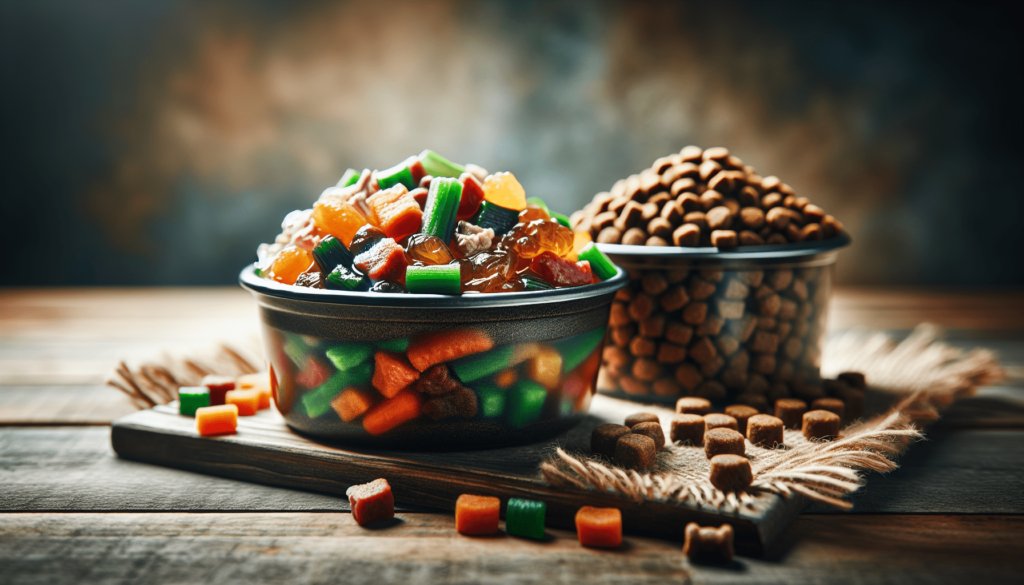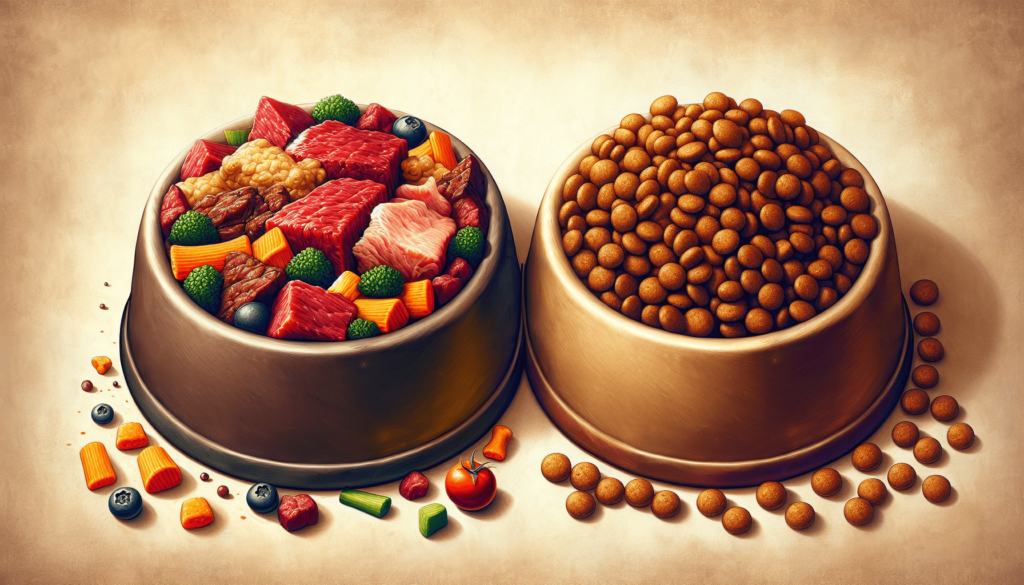Have you ever paused to wonder what the differences are between wet and dry dog food? As a dog owner, the choices you make about what you feed your furry friend can be overwhelming. Let’s be honest—deciding what’s best for your dog’s health and happiness isn’t as simple as picking the prettiest packaging or choosing what’s on sale. It involves understanding what each type of dog food offers in terms of nutrition, convenience, cost, and even environmental impact. In this article, I’ll take you through the nuances of wet versus dry dog food to help you make an informed decision that both you and your dog can feel good about.

Understanding Wet Dog Food
Wet dog food is a popular choice among pet owners, especially for those seeking to provide their dogs with a juicy, flavorful meal. Packaging for wet dog food usually consists of cans, pouches, or trays filled with a paté, stew, or chunk-in-gravy format. This type of food is often more aromatic and appetizing to dogs, which can be ideal for picky eaters or those with diminished appetites.
Nutritional Composition of Wet Dog Food
When it comes to nutrition, wet dog food is typically high in moisture content, which is its most significant distinction from dry food. This moisture content—often around 75% or more—not only helps keep the food fresh but also aids in hydration. Dogs that are prone to urinary tract issues or those that simply don’t drink much water can benefit from the additional moisture wet food provides. That said, not every wet dog food will have a balanced nutrient profile, so it’s crucial to choose products that meet AAFCO (Association of American Feed Control Officials) standards for a complete and balanced diet.
Advantages of Wet Dog Food
One major advantage of wet dog food is its palatability. Dogs often find it more flavorful and appealing, which can be a boon if your dog is a picky eater or has a decreased appetite due to age or illness. Another benefit is the added hydration; the high moisture content can be especially beneficial for pets dealing with urinary or kidney issues. Wet food is also easier for dogs with dental issues to chew and swallow.
Disadvantages of Wet Dog Food
On the downside, wet dog food can be messy and inconvenient to handle, particularly when dealing with leftovers. There’s also typically a higher cost associated with wet dog food compared to dry food, both on a per-serving basis and in terms of shelf life, as opened wet food needs to be refrigerated and used quickly. Furthermore, the weight of cans and pouches can be cumbersome when purchasing in bulk, and environmental impacts from packaging waste should also be considered.
Understanding Dry Dog Food
Dry dog food, commonly referred to as kibble, is a staple in many pet households. Its convenience in storage and feeding is appealing, particularly to those with busy lifestyles. Dry dog food consists of a mixture of ingredients such as meat, grains, and vegetables, which are cooked into small, dry pieces.
Nutritional Composition of Dry Dog Food
Dry dog food is known for having a lower moisture content, generally around 10%, which makes it less perishable and easy to store. Despite the lower moisture, high-quality kibble can still offer a balanced diet rich in protein, carbohydrates, and essential nutrients. It’s important to read labels and choose products that adhere to AAFCO’s standards to ensure your dog receives a nutritious diet.
Advantages of Dry Dog Food
Convenience is a significant advantage of dry dog food. It can be left out for extended periods without spoiling, making it a practical choice for dog owners who work away from home. Dry food can also contribute to dental hygiene benefits; the act of chewing kibble can help reduce tartar buildup. Furthermore, dry dog food is often more cost-effective, translating to savings over time.
Disadvantages of Dry Dog Food
However, not all is perfect with kibble. Some dogs may find it less appetizing compared to the aromatic wet food varieties, making picky eaters more challenging to feed. Additionally, the lack of moisture can be a drawback for dogs that require additional hydration, such as those with renal issues or lower water intake.

Comparing Wet and Dry Dog Food
Below is a table summarizing the primary distinctions between wet and dry dog food to provide a clearer perspective on your options:
| Feature | Wet Dog Food | Dry Dog Food |
|---|---|---|
| Moisture Content | High (around 75% or more) | Low (about 10%) |
| Storage | Requires refrigeration after opening | Easy to store and handle |
| Cost | Generally more expensive | Generally more cost-effective |
| Convenience | Messy and limited shelf life once opened | High convenience; can be left out |
| Palatability | More appealing to many dogs | May be less appealing to picky eaters |
| Dental Benefits | None; Can contribute to plaque | Chewing can reduce tartar |
| Hydration | Provides hydration, beneficial for some health issues | Does not aid hydration |
Making the Right Choice for Your Dog
Considerations for Choosing Dog Food
Deciding on the right food involves evaluating several factors, including your dog’s age, health conditions, lifestyle, and preferences. Puppies require a higher protein intake for growth, while senior dogs might benefit from more fiber and lower calories. Some dogs may require special diets due to medical conditions, such as kidney disease or allergies.
Blending Wet and Dry Dog Food
Some dog owners find that mixing wet and dry food provides a balanced approach that offers the benefits of both types. Combining the two can enhance meal palatability, increase moisture intake, and still take advantage of the nutritional benefits offered by dry kibble. Be cautious about overfeeding and consult your veterinarian to ensure you maintain an appropriate dietary balance.
Consultation with the Veterinarian
Always discussing your dog’s dietary needs with a veterinarian is advisable. Vets can provide guidance on any specific nutritional needs or restrictions based on your dog’s medical history and current health status.
Addressing Common Misconceptions
Is Wet Food Better than Dry for All Dogs?
It’s a common misconception that wet food is superior for all dogs, but each dog may have unique dietary requirements. The best choice depends on individual needs, including any health conditions your dog may have.
Does Dry Food Clean Dogs’ Teeth?
While dry food can contribute to mechanically reducing plaque, it does not replace the need for regular dental care. Chewing kibble can help, but brushing and routine dental checkups remain crucial for optimal dental health.
Can Wet Food Cause Obesity?
Obesity can stem from overfeeding any type of food, whether wet or dry. It’s not the moisture content that contributes to weight gain but rather the total calorie intake. Always adhere to feeding guidelines and monitor your dog’s weight regularly.
Frequently Asked Questions
What are the differences between wet and dry dog food?
Wet dog food is typically higher in moisture, more palatable to dogs, and requires refrigeration after opening. Dry dog food is low in moisture, convenient, often more cost-effective, and may provide dental benefits through chewing.
Can I mix wet and dry dog food?
Yes, mixing wet and dry dog food can offer a balanced diet and make meals more appealing for your dog. Consult with your veterinarian to ensure a suitable balance for your dog’s needs.
How do I transition my dog from wet to dry food or vice versa?
Gradually introduce the new food type by mixing it with the current food over a week or so. Begin with a small amount of the new food and increase the proportion gradually while observing your dog for any adverse reactions.
Does wet dog food spoil faster than dry food?
Yes, wet dog food typically requires refrigeration after opening and should be consumed within a few days, whereas dry food can remain fresh for longer if stored properly in an airtight container.
Ultimately, choosing between wet and dry dog food boils down to understanding your dog’s individual needs and responding appropriately. Whether you opt for the convenience of kibble, the palatability of canned food, or a mix of both, prioritizing a balanced diet tailored to your dog is essential for their long-term health and happiness.



